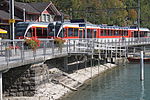Tannhorn
Bern–Lucerne borderCanton of Bern mountain stubsEmmental AlpsMountains of SwitzerlandMountains of the Alps ... and 4 more
Mountains of the canton of BernMountains of the canton of LucerneSwitzerland geography stubsTwo-thousanders of Switzerland

The Tannhorn is a mountain of the Emmental Alps in Switzerland. It lies to the west of the Brienzer Rothorn and to the east of the Augstmatthorn. On its southern side it overlooks Lake Brienz. Administratively, the summit is shared by the municipalities of Brienz, to the south and east, Oberried am Brienzersee, to the west, and Flühli, to the north-east. Brienz and Oberried am Brienzersee are in the canton of Bern, whilst Flühli is in the canton of Lucerne. The Tannhorn is the southernmost point in the canton of Lucerne.
Excerpt from the Wikipedia article Tannhorn (License: CC BY-SA 3.0, Authors, Images).Tannhorn
Hängebrücke Unterweidligraben,
Geographical coordinates (GPS) Address Nearby Places Show on map
Geographical coordinates (GPS)
| Latitude | Longitude |
|---|---|
| N 46.774833333333 ° | E 7.9843888888889 ° |
Address
Hängebrücke Unterweidligraben
3854
Bern, Switzerland
Open on Google Maps










